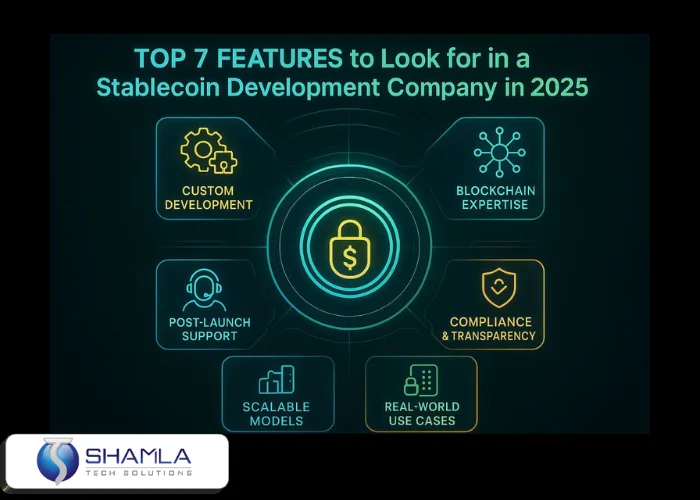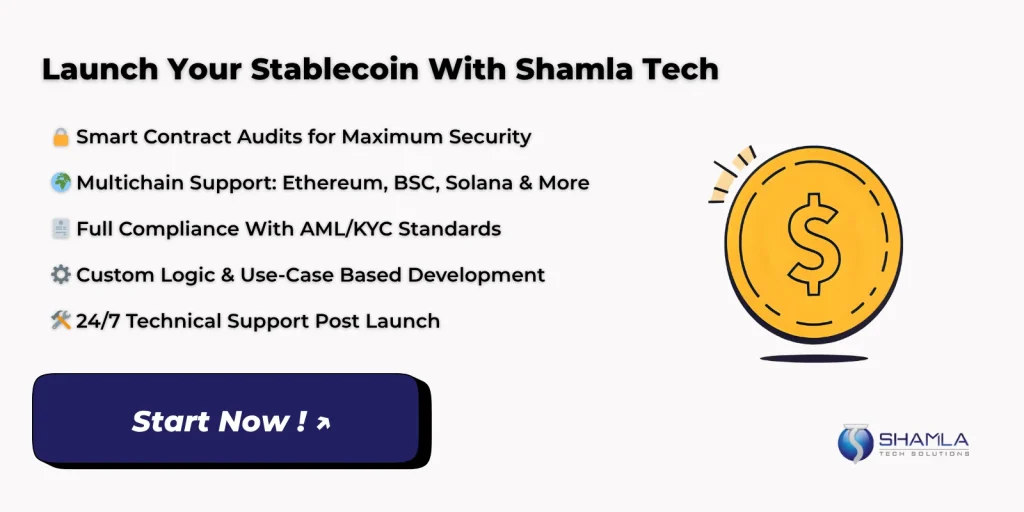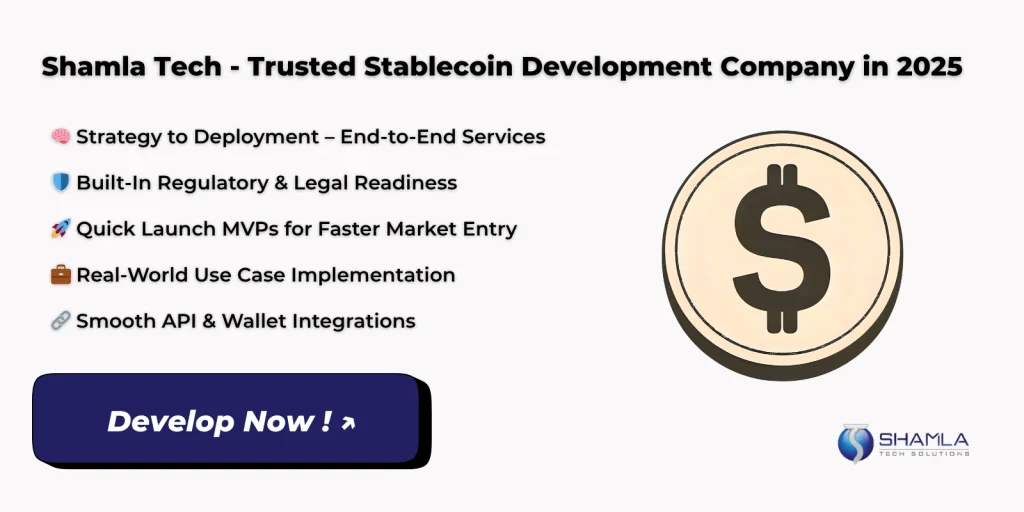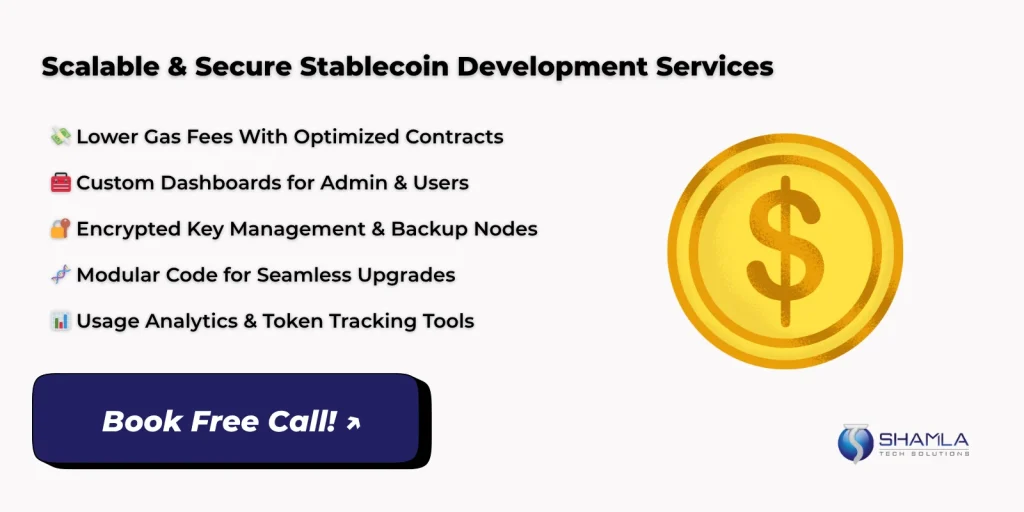7 Features to Look for in a Stablecoin Development Company in 2025
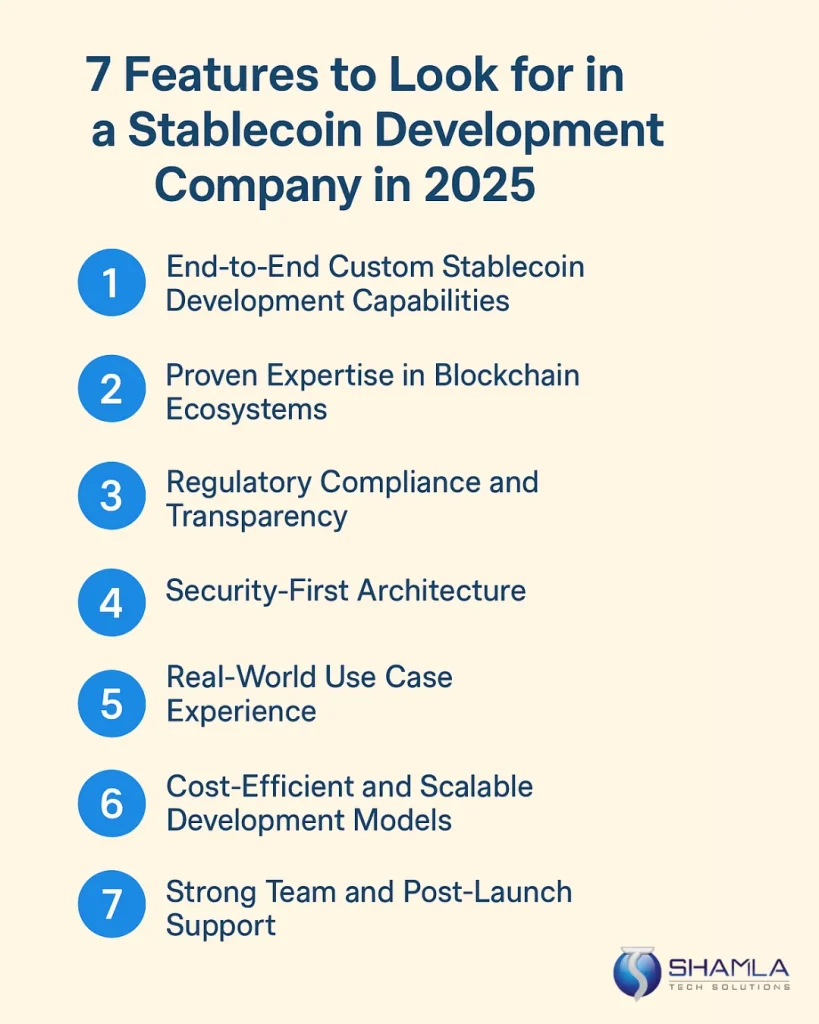
Feature 1: End-to-End Custom Stablecoin Development Capabilities
A stablecoin development company that handles every project stage keeps work flowing smoothly. From initial design and smart contract coding to wallet setup and user dashboard creation, one team avoids gaps or delays. They map your needs, build custom logic, and test on real networks. After launch, they stick around for bug fixes and updates. This full-service model cuts handoffs, speeds delivery, and holds one team accountable for every feature and tweak you need.
Custom stablecoin development lets you shape coins for things like loyalty points or internal credits. A firm skilled in blockchain stablecoin development picks public or private chains to match your goals. Private stablecoin development adds control and privacy for closed systems. If your needs change mid-project, they adjust code and settings without starting over. This flexible approach ensures your coin fits your exact use case, scales smoothly, and adapts to new rules or user feedback.
How this helps:
- One vendor means clear ownership, faster fixes, no finger-pointing.
- In-house work cuts coordination delays and extra costs.
- Seamless updates keep your coin stable and secure.
- Tailored logic supports unique business demands, rules, and real-world stablecoin use cases.
- Gas-fee tweaks lower costs for end users.
- Agile changes adapt to legal or market shifts.
Feature 2: Proven Expertise in Blockchain Ecosystems
A strong stablecoin development company understands chains like Ethereum, Solana, Polygon, and BSC. Each network stores data and handles transactions in its own way. Teams with real blockchain stablecoin development background know how to keep gas fees low and transaction speed high. They choose the best chain for your use case and design smart contracts that avoid network jams. This expertise prevents outages, limits costs, and ensures your coin stays stable even under heavy load.
Stablecoin adoption grows when coins work across wallets, exchanges, and apps. A provider skilled in multichain builds bridges so your stablecoin moves freely between networks. They set up oracles and relayers for accurate price feeds and secure transfers. Blockchain stablecoin development here means planning for future cross-chain features, letting you tap DeFi apps or payment gateways on multiple networks without extra work.
How this helps:
- Faster transactions on low-fee networks.
- Avoids downtime during traffic spikes.
- Broad user access through multichain support.
- Easier listings on wallets and exchanges.
- Ready for cross-chain DeFi integrations.
- Scales as your user base grows.
Feature 3: Regulatory Compliance and Transparency
Stablecoins tie to real money, so laws matter. A top stablecoin development company builds in AML/KYC tools and audit logs from day one. They know stablecoin regulation in the U.S., EU’s MiCA rules, and other markets. Smart contracts include checks to block suspicious activity without slowing transactions. This approach ensures your coin passes legal reviews and gains quick approval for exchange listings.
Custom stablecoin development must cover legal structuring, entity setup, and reporting. Even private stablecoin development systems need clear transaction trails and user controls. Your provider adds dashboards for compliance officers and automated alerts for unusual flows. This transparency builds user trust and shields your business from fines or forced shutdowns.
How this helps:
- Avoids legal fines and project delays.
- Simplifies exchange and banking partnerships.
- Builds confidence among regulators and users.
- Enables quick response to new rules.
- Makes audits fast with built-in logs.
- Prevents costly rewrites when laws change.
Feature 4: Security-First Architecture
Security is non-negotiable. A solid stablecoin development company embeds safety into every layer. Smart contracts go through manual and automated audits. Teams run bug bounties and strict code reviews to spot flaws early. They set up role-based access so only authorized staff can change settings or move funds.
Blockchain stablecoin development also includes network defenses: firewalls, intrusion detection, and backup nodes. A private stablecoin development setup adds VPN tunnels and isolated servers. Disaster recovery plans ensure your coin stays online even if an attack hits. This proactive stance cuts risks and protects user funds.
How this helps:
- Prevents theft and contract exploits.
- Strengthens user trust in your stablecoin.
- Meets security audit requirements easily.
- Limits damage if an incident occurs.
- Keeps operations running under attack.
- Reduces insurance and compliance costs.
Feature 5: Real-World Use Case Experience
Pick a stablecoin development company that has successfully delivered real-world projects. They’ve built CBDCs, DeFi tokens, payment rails, and remittance coins. This background means they know common pitfalls and best practices for each sector. They tailor features like transaction caps or expiry dates to fit actual business needs.
Stablecoin solutions provider teams with live deployments can share case studies and metrics. You learn from their past work – what boosted adoption, what slowed usage, and skip trial-and-error. Custom stablecoin development then focuses on features that matter, saving time and budget.
How this helps:
- Avoids generic templates that miss key industry needs.
- Speeds up time-to-market with proven modules.
- Builds investor confidence via real-world stats.
- Focuses budget on high-impact features only.
- Reduces testing cycles with tested flows.
- Aligns products with target user habits.
Feature 6: Cost-Efficient and Scalable Development Models
Long-term value matters. A good stablecoin development company plans for growth. They write modular code, use cloud services, and separate data stores so adding users or features won’t break the system. This approach lowers future costs and avoids major rewrites.
Transparent pricing – showing cost of stablecoin development per module, builds trust. Teams use DevOps pipelines for fast updates and continuous testing. An MVP-first launch lets you start small, gather feedback, then expand. This keeps budgets under control and speeds early release.
How this helps:
- Predictable budgets with clear cost breakdowns.
- Faster updates with automated pipelines.
- Handles growth without downtime.
- Adds features in stages to match budgets.
- Lowers ops costs via cloud scaling.
- Gets to market quickly with MVP.
Feature 7: Strong Team and Post-Launch Support
Building your coin is just the start. A top stablecoin development company stays on call for bug fixes, upgrades, and help with new rules. Their team comprises blockchain developers, QA engineers, security specialists, and dedicated support personnel. They work under SLAs to guarantee response times.
For private stablecoin development, you may need frequent changes. A solid provider offers regular health checks, performance reports, and optional staff augmentation, hiring stablecoin developers through them as your needs grow. This keeps your project agile even after launch.
How this helps:
- Fast fixes and zero downtime under SLA.
- Smooth upgrades as new tech arrives.
- Expert help for in-house teams when needed.
- 24/7 monitoring catches issues early.
- Scales support with your user base.
- Ensures long-term success and reliability.
Checklist to Evaluate a Stablecoin Development Company
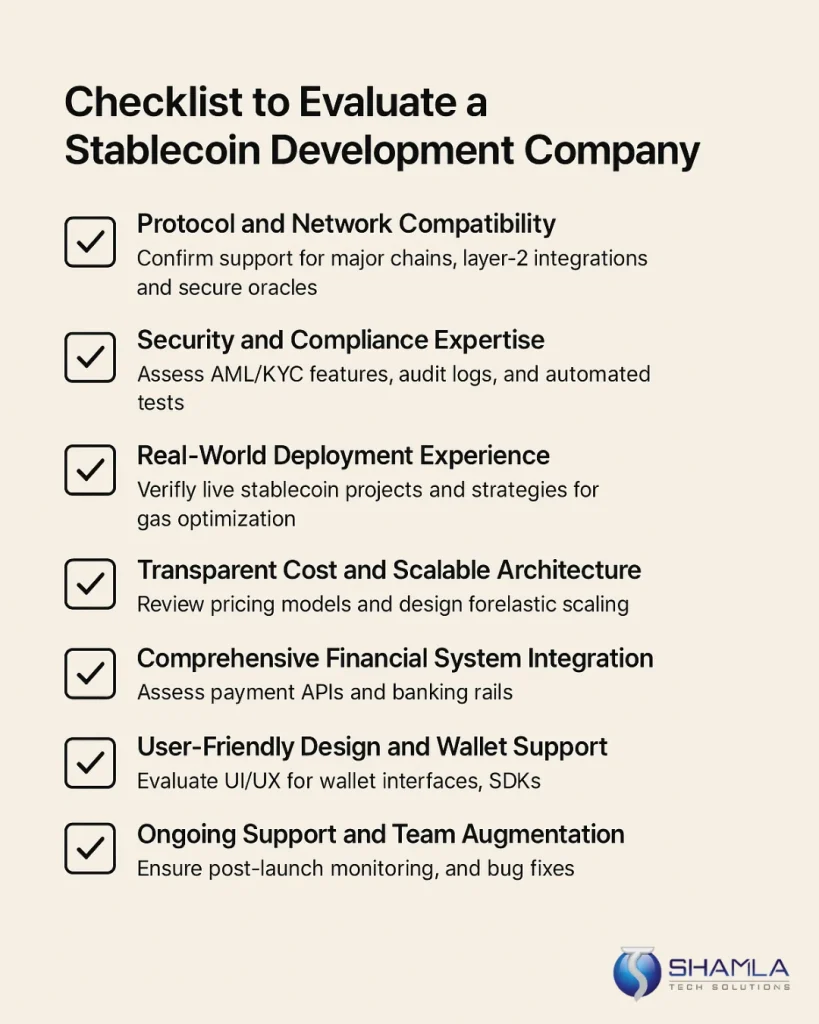
1. Protocol and Network Compatibility
2. Security and Compliance Expertise
3. Real-World Deployment Experience
4. Transparent Cost and Scalable Architecture
5. Comprehensive Financial System Integration
Assess how the partner integrates your stablecoin with existing financial systems. They should design REST or gRPC APIs for payment gateways, banking rails, ERP platforms, and custody providers. Confirm support for ISO 20022 messaging, SWIFT transfers, and common payment processors. Review their wallet-to-bank workflows, currency-hedging tools, and KYC provider integration. Check API docs clarity, sandbox environments, and end-to-end testing plans. Robust integration removes manual data bridges, speeds user onboarding, and ensures real-time settlement. If required, they can hire stablecoin developers to augment your team.
6. User-Friendly Design and Wallet Support
7. Ongoing Support and Team Augmentation
Why Shamla Tech is the Best Stablecoin Development Company in 2025
Shamla Tech leads the market as a leading stablecoin development company with proven blockchain expertise, unmatched compliance know-how, and hands-on post-launch support. We’ve developed several high-performance coins across Ethereum, Solana, and various layer-2 chains, featuring oracle integration, privacy-focused transaction layers, and built-in automated KYC systems.
We deliver clear cost breakdowns for stablecoin development services and provide scalable DevOps pipelines to ensure zero downtime. Clients praise our flexible architecture, seamless API integrations with banking rails, and user-friendly wallet SDKs. Our 24/7 monitoring, emergency response protocols, and on-demand hire stablecoin developers service guarantee your project’s long-term success and regulatory readiness.
5 Reasons Shamla Tech Outperforms Other Stablecoin Development Companies:
- Tight security audits and bug bounties ensure your coin is hacker-proof and regulatory compliant without slowing development or user transactions.
- Our modular smart contracts enable quick feature updates, seamless chain migrations, and reliable custom stablecoin development tailored to evolving business needs.
- Clear pricing and MVP-first roadmaps keep the cost of stablecoin development under control, with transparent quotes and no hidden fees.
- Dedicated support teams handle integration with payment processes, bank APIs, and ERP systems, ensuring seamless fiat ramp-on and ramp-off.
- Expert blockchain engineers and UI/UX designers build intuitive wallets, responsive dashboards, and cross-platform SDKs for instant user adoption.

